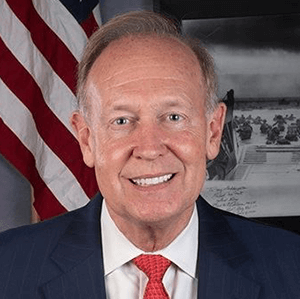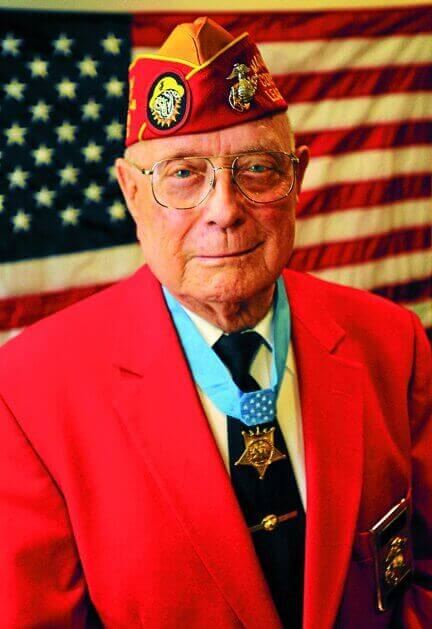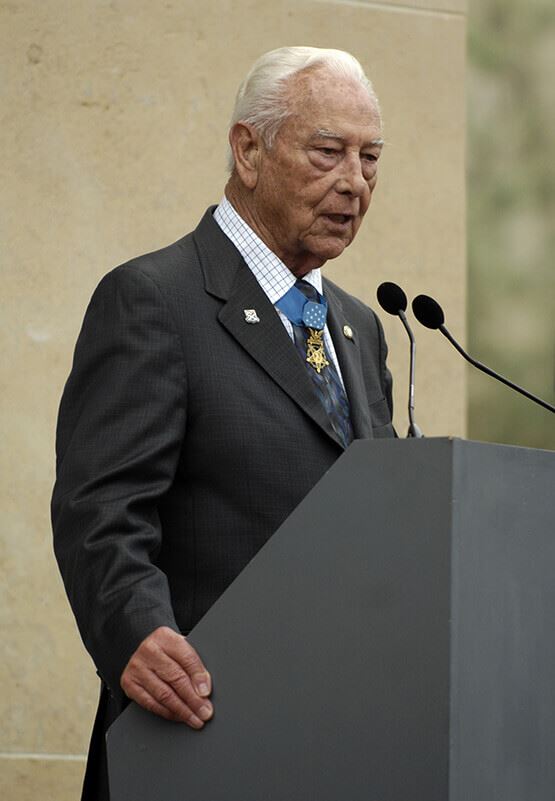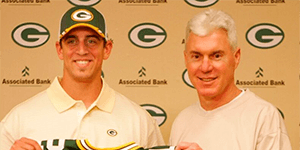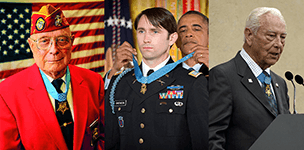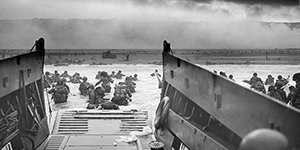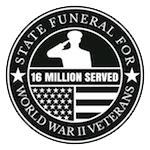3 Real American Heroes from World War 2 & War of Terror
America in many ways was built on admiration. In my generation, we grew up with the 1970 movie Patton where he reminds his World War 2 troops "America has always loved a winner and will not tolerate a loser." He went on to say "When you were kids, you all admired the champion marble shooter, the fastest runner, the All-American football players, the toughest boxers. American's play to win all the time." These days America is at a crossroads with people split on how they view a winning America. One group that every US citizen agrees is a winner is our military members - American heroes. Let's look in-depth at three American's who have all received our nation's highest award, the Congressional Medal of Honor. Two are living and one has passed. Two were in the US Army and one was a Marine. Two were enlisted men at the time they had their medal of honor action and another was a Captain. The two oldest are from World War 2 and the youngest from the War on Terror. Our World War 2 Veterans are high school educated and the gentleman from the War on Terror is a university graduate. They have much in common and represent the very best that America has to offer. They have all been victors in this "Medal of Honor Game." Each has what some call "the American Gold Medal" or "Congressional Gold Medal" in their possession. Each of these men fully understood the fact that our freedoms and liberty are not guaranteed but hard-fought. Let's see how these three men inspired and led America to victory. World War 2 & The War of Terror : 3 Real American Heroes
Woody Williams - World War 2 - The Battle of Iwo JimaIn May of 1943, Woody joined the Marines and was promptly shipped off to the Pacific Theater a few months later. The dairy farmer from West Virginia was trained to be a demolition sergeant, which meant he knew how to use flamethrowers. One of the biggest actions he saw was taking part in the battle to retake Guam in the summer of 1944 before being sent to Iwo Jima. These two battles were extremely different. "Guam was more jungle-type fighting — a lot of creeping and crawling — but when we got to Iwo Jima, everything had been wiped off that island." "About the only protection you could find would be a shell crater or try to dig your own hole." "Trying to dig a hole in that stuff was like trying to dig a hole in marbles," Williams explained of the volcanic island. "Trying to run on it was almost impossible. You couldn't get a foothold." The tanks had trouble opening up a lane for the infantry through the sand, too, but the biggest problem was the many steel-reinforced pillboxes. Woody said, "Bazookas and that sort of thing had no effect on them because they were so thick and well built." "The only way to actually eliminate the enemy inside those pillboxes was by the flamethrower." Quick to volunteer his services when American tanks were maneuvering to open a lane for the infantry to come through the network of reinforced concrete pillboxes and buried mines, Williams went forward alone to attempt to stop the devastating machine-gun fire from the unyielding positions. Covered only by four riflemen, Woody fought desperately for hours under heavy enemy small-arms fire and repeatedly returned to his own lines to prepare demolition charges and obtain serviced flamethrowers. On one occasion, he mounted a pillbox to insert the nozzle of his flamethrower through the air vent, killing the occupants, and silencing the gun; on another, he grimly charged enemy riflemen who attempted to stop him with bayonets and destroyed them with a burst of flame from his weapon. His unyielding determination and extraordinary heroism in the face of ruthless enemy resistance were directly instrumental in neutralizing one of the most heavily defended Japanese strongpoints encountered by his regiment and aided vitally in enabling his company to reach its objective. Woody's aggressive fighting spirit and valiant devotion to duty throughout this action sustained and enhance the highest traditions of the U.S. Naval Service. He received the MOH for conspicuous gallantry and intrepidity at the risk of his life above and beyond the call of duty as demolition sergeant serving with the 21st Marines, 3rd Marine Division, in action against enemy Japanese forces on Iwo Jima, Volcano Islands, 23 February 1945. See Woody on the media from recent years 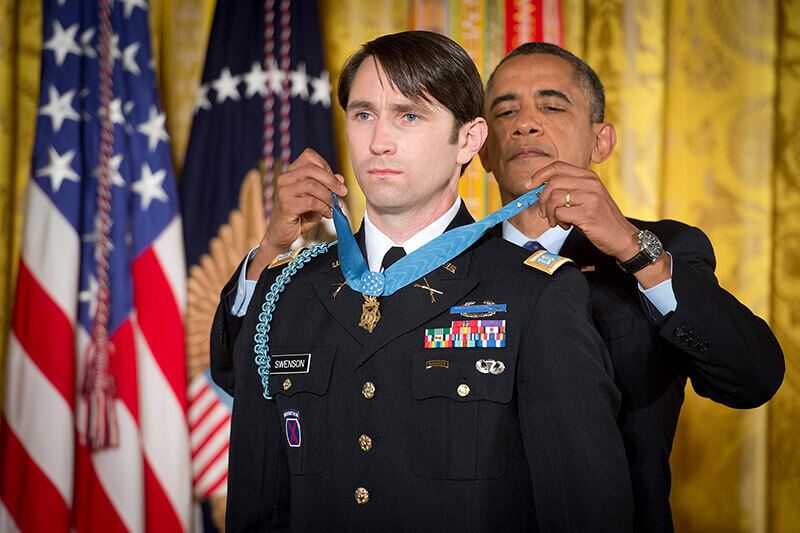
William D. Swenson - The War of TerrorCaptain William D. Swenson distinguished himself with acts of gallantry at the risk of his life above and beyond the call of duty while serving during combat operations against an armed enemy in Kunar Province, Afghanistan on September 8, 2009. On that September morning, more than 60 heavily-armed, well-positioned enemy fighters ambushed Captain Swenson's combat team as it moved on foot into the village of Ganjgal for a meeting with village elders. As the enemy unleashed a barrage of rocket-propelled grenade, mortar, and machine-gun fire, Captain Swenson immediately returned fire and coordinated and directed the response of his Afghan Border Police, while simultaneously calling in suppressive artillery fire and aviation support. After the enemy effectively flanked Coalition Forces, Captain Swenson repeatedly called for smoke to cover the withdrawal of the forward elements. Surrounded on three sides by enemy forces inflicting effective and accurate fire, Captain Swenson coordinated air assets, indirect fire support, and medical evacuation helicopter support to allow for the evacuation of the wounded. Captain Swenson ignored enemy radio transmissions demanding surrender and maneuvered uncovered to render medical aid to a wounded fellow soldier. Captain Swenson stopped administering aid long enough to throw a grenade at approaching enemy forces, before assisting with moving the soldier for air evacuation. With complete disregard for his own safety, Captain Swenson unhesitatingly led a team in an unarmored vehicle into the kill zone, exposing himself to enemy fire on at least two occasions, to recover the wounded and search for four missing comrades. After using aviation support to mark locations of fallen and wounded comrades, it became clear that ground recovery of the fallen was required due to heavy enemy fire on helicopter landing zones. Captain Swenson's team returned to the kill zone another time in a Humvee. Captain Swenson voluntarily exited the vehicle, exposing himself to enemy fire, to locate and recover three fallen Marines and one fallen Navy corpsman. His exceptional leadership and stout resistance against the enemy during six hours of continuous fighting rallied his teammates and effectively disrupted the enemy's assault. Captain William D. Swenson's extraordinary heroism and selflessness above and beyond the call of duty are in keeping with the highest traditions of military service and reflect great credit upon himself, Task Force Phoenix, 1st Battalion, 32nd Infantry Regiment, 3rd Brigade Combat Team, 10th Mountain Division, and the United States Army.
Walter Ehlers - World War 2 - D-Day invasion of FranceStaff Sgt. Ehlers, always acted as the spearhead for his unit, repeatedly leading his men against heavily defended enemy strongpoints, exposing himself to hostile fire whenever the situation required heroic and courageous leadership. Without waiting for an order, Staff Sgt. Ehlers, far ahead of his men, led his squad against a stoutly defended enemy strongpoint, personally killing four men of the enemy patrol who attacked him en route. Then crawling forward under withering machine-gun fire, he trounced upon the gun-crew and put it out of action. Turning his attention to two mortars protected by the crossfire of two machine guns, Staff Sgt. Ehlers led his men through this hail of bullets to kill or put to flight the enemy of the mortar section, killing three men himself. After mopping up the mortar positions, he again advanced on a machine gun, his progress effectively covered by his squad. Staff Sgt. Ehlers knew the only way to make it through this intense battle was to keep moving forward and not looking back. When he was almost on top of the next gun he leaped to his feet and, although greatly outnumbered, he knocked out the position singlehandedly. The next day, having advanced deep into enemy territory, the platoon of which Staff Sgt. Ehlers was a member finding itself in an untenable position as the enemy brought increased mortar, machine-gun, and small-arms fire to bear on it, was ordered to withdraw. Staff Sgt. Ehlers, after his unit had covered the withdrawal of the remainder of the platoon, stood up and by continuous fire at the semicircle of enemy placements, diverted the bulk of the heavy hostile fire on himself, thus permitting the members of his own squad to withdraw. This is the most prime example of the courage it takes to be a Medal of Honor candidate. He blatantly put his life at stake for the betterment and safety of others in his platoon. At this point, he carried one of his wounded riflemen to' safety and then returned fearlessly over the shell-swept field to retrieve the automatic rifle that he was unable to carry previously. After then having his wounds treated, he refused to be evacuated and returned to lead his squad. The courageous leadership and fearless aggressiveness displayed by Staff Sgt. Ehlers in the face of overwhelming enemy forces served as an inspiration to others. He received the Medal of Honor for conspicuous gallantry and intrepidity at the risk of his life above and beyond the call of duty on 9-10 June 1944 near Gonville, France. The Medal of Honor as we know it now always goes to someone who went above and beyond in their call of duty on the battlefield. But, between World War 1 and World War 2, America was marked by a time of postwar disillusionment. Throughout the 1920s, the Medal of Honor was still awarded, mostly to members of the Navy who performed non-combat acts above the call of duty. An example is William Huber who served in the Navy in World War 1 and World War 2, although his medal came during a time of peace on June 11, 1928. During this peacetime, William was a machinist on the USS Bruce that was stationed at the shipyard in Norfolk, Virginia. In the early morning on June 11th, there was a massive explosion in the ship's boiler room. William Huber showed his act of courage when he carried several of his fellow crewmates to safety and continued to do so even with serious burns on his whole body. The coming of World War 2 would end the practice of awarding the medal to noncombatants and place it once and for all in the crucible of battle. The holders in the future would be famous for annihilating the enemy, saving their fellow soldiers, sailors, airmen or Marines, or both. These three men like the other 3,523 have shown conspicuous gallantry and intrepidity at the risk of his life above and beyond the call of duty on and off the battlefield. There is an uncanny ability all of these incredible men have for having the heart and mindset to put their life at risk for the safety of everyone else. Our country, led by these brave warriors, must keep fighting every day to ensure we keep the freedoms we so enjoy. Elmer Davis, the Director of the United States Office of War Information for WWII said, "This nation will remain the land of the free only so long as it is the home of the brave." The Congressional Medal of Honor Society uses these words to describe a MOH recipient, "Gallantry in action. Intrepidity. Above and beyond the call of duty. Risk of life. Selflessness. Exemplary action. Unwavering devotion. Conspicuous gallantry. Extraordinary heroism." The society goes on to say, "The words enshrined with the Medal of Honor citations capture the best of what it means to be human." By remembering, supporting, and honoring the sacrifice of these recipients as well as, by sharing their stories we can honor these men and women by continuing to fight for what is near and dear to our republic. Thomas Paine put it very eloquently when he explained why it is important that we remember these brave soldiers. He said, "Those who expect to reap the blessings of freedom, must, like men, undergo the fatigues of supporting it." Franklin D. Roosevelt also expresses the thought that we must fight for our liberty and freedom when he says, "In the truest sense, freedom cannot be bestowed; it must be achieved." Our Medal of Honor holders represent the very best of America. They truly know what it means to be a united country for one purpose. Michael Thornton, a CMOHS recipient from the Vietnam War said, "This Medal of Honor does not belong to me. This medal belongs to every man and woman who has ever served their country. We were doing what we were trained to do. We were doing our job." These men and women are simply doing their duty to their country. "America was not built on fear. America was built on courage, on imagination and an unbeatable determination to do the job at hand." — Harry S. Truman | Suggested Articles |
| Privacy Policy Site Map 501(c)(3) Status Disclaimer |
